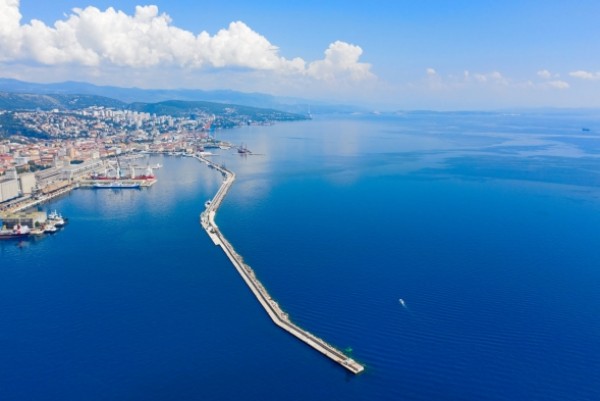For cargo coming from the Far East, the travel time of goods is shortened by a few days. Ports in the south have invested heavily in recent years in their hinterland connections and digitalisation.
Container transport by rail between China and Europe has greatly increased compared to last year. It is known that the New Silk Road has been less used for freight transport for years, but it has only recently become a current option due to the new situation in the transport of goods from the Far East.
In rail transport, 40-foot-tall freight DRY containers are used for the transport of general cargo, and various machinery, machines or parts of machines, electronic components, metal and plastic products and the like are mostly transported.
As far as maritime transport is concerned, it is still the most popular freight option because it is the most affordable. It offers a wide range of transport services from full (FCL - full load container), groupage containers (LCL - less container load), as well as special special transport solutions tailored to the needs of all users.
For Central European countries such as Slovakia, Austria or Hungary, the Adriatic ports of Koper, Rijeka and Trieste are of exceptional importance. If we take Budapest as an example, we will see that the distance from Koper, Rijeka or Trieste is only 570 kilometers, while from Hamburg it is as much as 1,200 kilometers. Thus, goods from Adriatic ports reach their destination much faster.
- Adriatic ports, and here I especially emphasize the port of Rijeka, especially the previous two years (2019 and 2020) are increasingly in the focus of major world shipping companies that direct their cargo to the countries of Central Europe and the Western Balkans through Rijeka using all the benefits of optimal geographical position, sufficient free capacity, but also increasing efficiency and productivity of both terminals and intermodal services, primarily railways on the wings of new investments of the Government of the Republic of Croatia and its extended arms of HŽ Infrastruktura and the Port of Rijeka Authority. COSCO Shipping continues to count on the development of Rijeka's transport route, to which it itself significantly contributes, and the expansion of intermodal services to third countries in accordance with market needs and projections, says Marko Škraljsky, general manager of Dragon Maritime Adria d.o.o., agent of Cosco Shipping Lines.
This is also confirmed by cargo-partner. They say that, although transport volumes recorded a slight decline compared to the previous year and despite the overall challenging market environment, the company can call last year successful thanks to customized emergency solutions and flexible alternatives. What they especially emphasize is that the amount of cargo can be related to the growth of online trade in Croatia and the region.
- It can be noticed that, depending on the type of goods, we can talk about an increase in turnover following the growth of online trade in Croatia and the region, consumer goods, sports equipment, food supplements, technical equipment, etc., said cargo-partner, the international transport and information logistics provider.
Statistics confirm the growth of container traffic. The company Adriatic Gate Container Terminal recently reported on a new record at the Brajdica container terminal in the port of Rijeka - 300,000 container units (TEU) were transhipped last year. This new record, as they point out, gains even greater significance when viewed in the context of the passing year and which, in all fields affected by the Covid-19 virus pandemic. The company Adriatic Gate Container Terminal (AGCT) was founded in 2001 as a subsidiary of the Port of Rijeka, and ten years later, in 2011, the company entered a strategic partner, International Container Terminal Service Inc. (ICTSI). The Philippine company has a 51 percent stake in AGTC and the Port of Rijeka a 49 percent stake.
This year should bring a recovery.
- If there are no major market shocks such as the current situation (lockdown, lack of containers, lack of passenger flights), we expect market recovery and slight growth, conclude the cargo-partner.
Currently, the market is experiencing increased demand for imports, which has resulted in the rapid filling of ship capacity. In other words, it takes time for containers from European ports to physically return to China, in order to be operational again for the import transport of goods. For these reasons, as well as breaks for the Chinese New Year, the transport of goods by sea, as the most economically viable option, was practically overbooked until March this year.
The year ahead should bring the outcome of the future of the container terminal on the Zagreb coast, after the Governing Board of the Port of Rijeka Authority suddenly decided to cancel the international tender for the selection of concessionaires at the end of 2020.
Two binding bids were received for the tender, one from a Chinese corporation consisting of Ningbo Zhoushan Port Company Limited (which manages the largest port in China and the world), Tianjin Port Overseas Holding Limited and China Road and Bridge Corporation (the company that builds the Peljesac Bridge) , and the second of the consortium consisting of APM Terminals (a subsidiary of the shipping giant Maersk) and Enna Logic (part of the domestic energy and logistics concern PPD Group).
The annuled tender will further complicate and stretch the already too long strip of about 400 meters long operational shoreline, whose construction took seven years (almost 15 years have passed since the first failed attempt to build), and about 120 million euros have been invested in it so far. The construction of the first phase of the terminal was completed in June 2019, and despite concrete offers, after the cancellation of the tender, no one still knows if and when the terminal will get a concessionaire expected to invest more than 150 million euros in equipping the terminal and upgrading another 280 meters of operational shore and their commissioning, which would more than double the capacity of Rijeka as a container port compared to the current ones.


